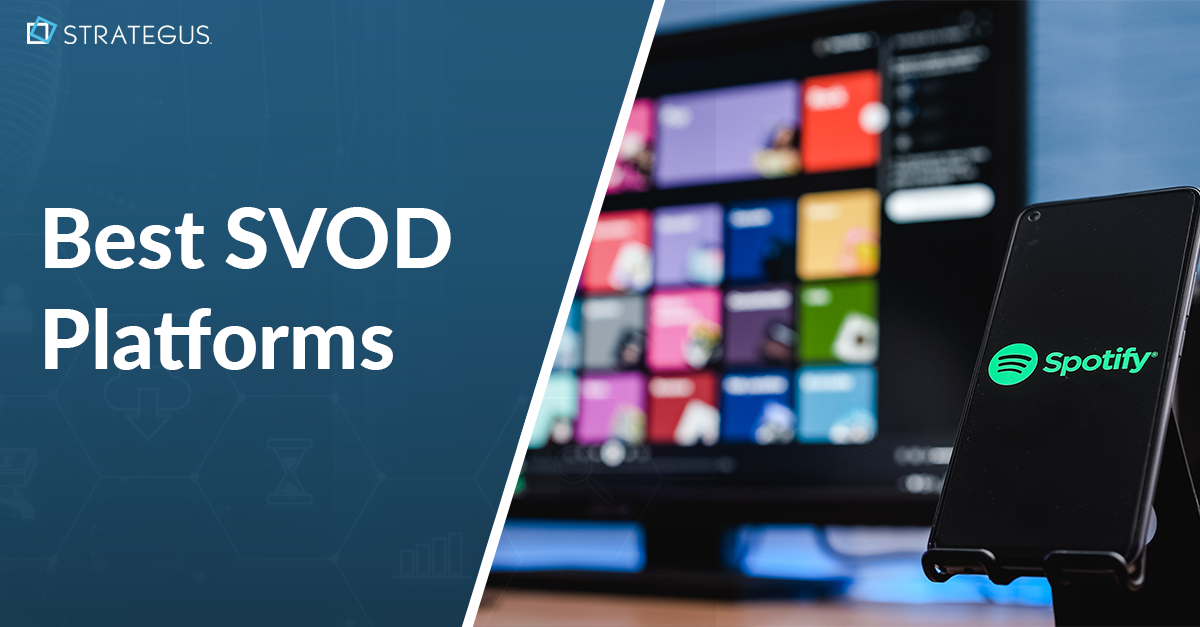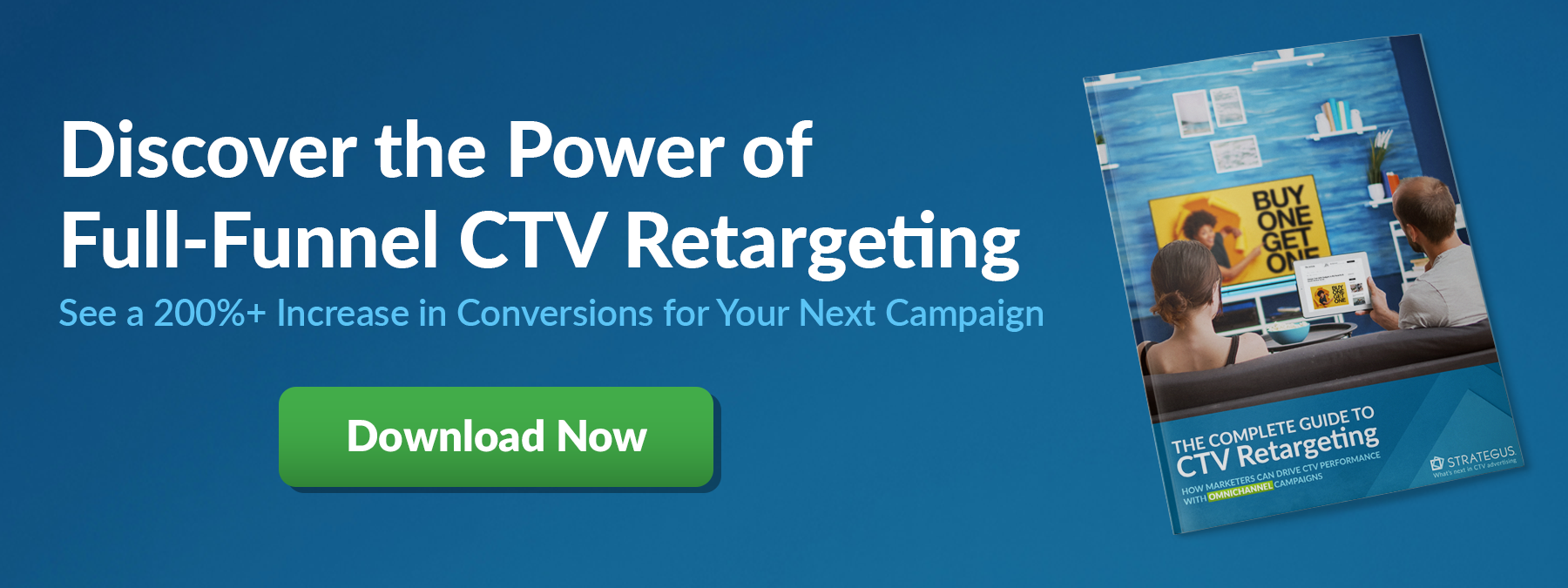- Home
- Strategus Blog
- CTV Targeting: 22 Tactics to Reach the Right Viewers
CTV Targeting: 22 Tactics to Reach the Right Viewers
 Traci Ruether
Traci Ruether
17 minutes read
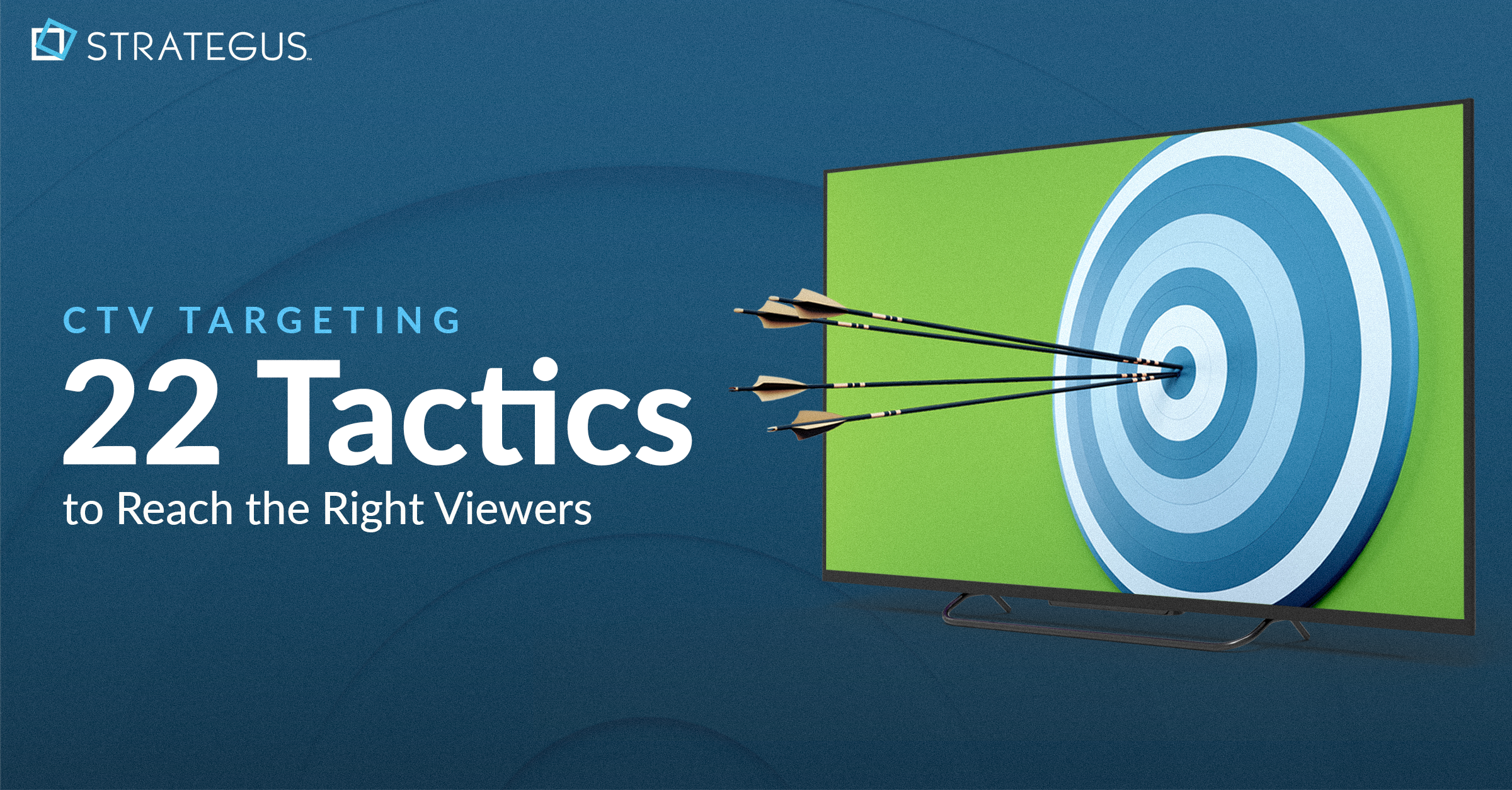
Targeted advertising has been around since the early days of the internet. And while it often brings to mind the ads we see while browsing the internet or scrolling through social media, programmatic targeting is also a major benefit of connected TV (CTV).
The fact of the matter is, CTV is digital. And in the same way that streaming providers use audience data to recommend relevant shows and movies, marketers can deliver relevant ad experiences using CTV targeting.
But just how sophisticated is this? With the right partnerships, it’s possible to build custom audiences based on a combination of personal interests, shopping behavior, CRM data, and more. From there, brands and agencies can even tailor ad creative to resonate with specific audience segments.
The result? Better campaign performance thanks to more personalized experiences.
How Does CTV Ad Targeting Work?
Programmatic CTV ads are purchased on a per-viewer basis as opposed to being tied to specific ad slots. This shifts the focus from the content where the ads run to the audience being served each ad, allowing advertisers to reach the right viewers across a variety of platforms.

Doing so involves a complex ecosystem of data providers and automated auctions (which you can read more about here). But for the sake of simplicity, CTV ad targeting involves three steps:
- Audience definition. First, marketers must identify which viewers they’d like to target. This should be informed by buyer personas and campaign goals. Because CTV offers powerful targeting options based on interests, purchase history, and other behaviors, it’s best to think beyond basic demographics by digging into what makes a brand’s ideal customers tick.
- Automated bidding. This information is then used to set audience parameters, which are shared with demand-side platforms (DSPs). These platforms use algorithms to decide which ad impressions to bid on — and at what price — by factoring in considerations like budget, the value of the specific audience segment, and competitor bids.
- Targeted ad delivery. From there, the highest bidder wins the impression, and the ad only plays to relevant viewers. Data is also collected throughout the process, providing valuable insights for retargeting efforts and attribution.
What Targeting Strategies Can Be Used to Locate Your Audience?
If you ask an AI chatbot to generate a list of CTV audience targeting tactics, you’d see things like demographic targeting, geographic targeting, and more. While accurate, these are table stakes of modern digital advertising.
CTV targeting gets more interesting (and effective) when ad are placed based on sophisticated insights, such as a user’s:

Online browsing activity

Recent life events

In-store purchase history
The list goes on.
What’s more, advertisers shouldn’t settle for a one-size-fits-all targeting strategy. We’ve found that the most effective approach is to create a custom audience by layering several targeting tactics. For that reason, we work with brands and agencies to identify the perfect mix of data sources to achieve campaign goals.
Here’s a look at all the CTV targeting capabilities out there — from run-of-the-mill offerings to the much more advanced approaches that we’ve developed at Strategus.
Third-Party Data Targeting
Third-party data is purchased from data management platforms and offers a broader view of the market. Advertisers rely on it to identify new audience segments and enhance targeting strategies. While this data is less precise than information gathered internally or through partnerships, it’s a good place to start when looking for new prospects.

1. Demographic Targeting
Demographic targeting uses detailed demographic information (age, gender, income) to reach the right audience segments for a campaign. Because demographic targeting is so broad, we’d only recommend using it as one parameter layered into a more comprehensive strategy.
Example: Say a financial services company wanted to promote services like student loan refinancing, investment advice, and credit card options to young professionals. With demographic CTV targeting, the firm could locate individuals between the ages of 25 and 35 within a specified income bracket.
2. Geotargeting
Pinpoint viewers by state, designated market area (DMA), zip code, or distance from a storefront to eliminate ad waste and focus on key regions. This is another tactic that should be combined with additional capabilities for enhanced precision.
Example: A regional grocery store chain could use geotargeting to reach viewers within a specific radius of their store locations. The brand could then enhance their targeting by layering in demographic information, such as household size and income level, to ensure their ads are reaching the most relevant audience. This approach not only maximizes ad spend but also increases the likelihood of driving foot traffic to their stores.
3. Behavioral Insight
Use data about browsing behavior, shopping habits, and online activities to serve highly relevant ads that align with user interests.
Example: This could include targeting users who frequently visit travel websites with ads for airlines or hotels. Alternatively, a grocery store chain could locate gluten-free households with a more relevant message.
4. Purchase History
Target customers based on their past purchasing patterns, thereby reaching frequent buyers, high-value customers, or specific product categories.
Example: Someone who regularly buys organic produce online might see ads for a local farmers' market.
5. Social Media Activity
Integrate social media data to connect with audiences based on their online interactions, preferences, and engagement levels. This could involve targeting users who follow certain brands or influencers on social media.
Example: A home services company could target users who’ve engaged with posts from a home improvement account.
6. Intent-Based Targeting
Use signals indicating a user's intent to purchase or engage, allowing for precise targeting during key decision-making moments.
Example: An auto dealer could rely on real-time buying signals from Edmunds to reach in-market car buyers.
Second-Party Data Targeting
Second-party data is first-party data that’s shared with another closely related company. Consider a publisher like Hulu that has proprietary data about the shows their viewers like to watch, where they’re located, and how they engage with their platform. Once this data is shared to help advertisers build targeted ad campaigns, it becomes second-party data.
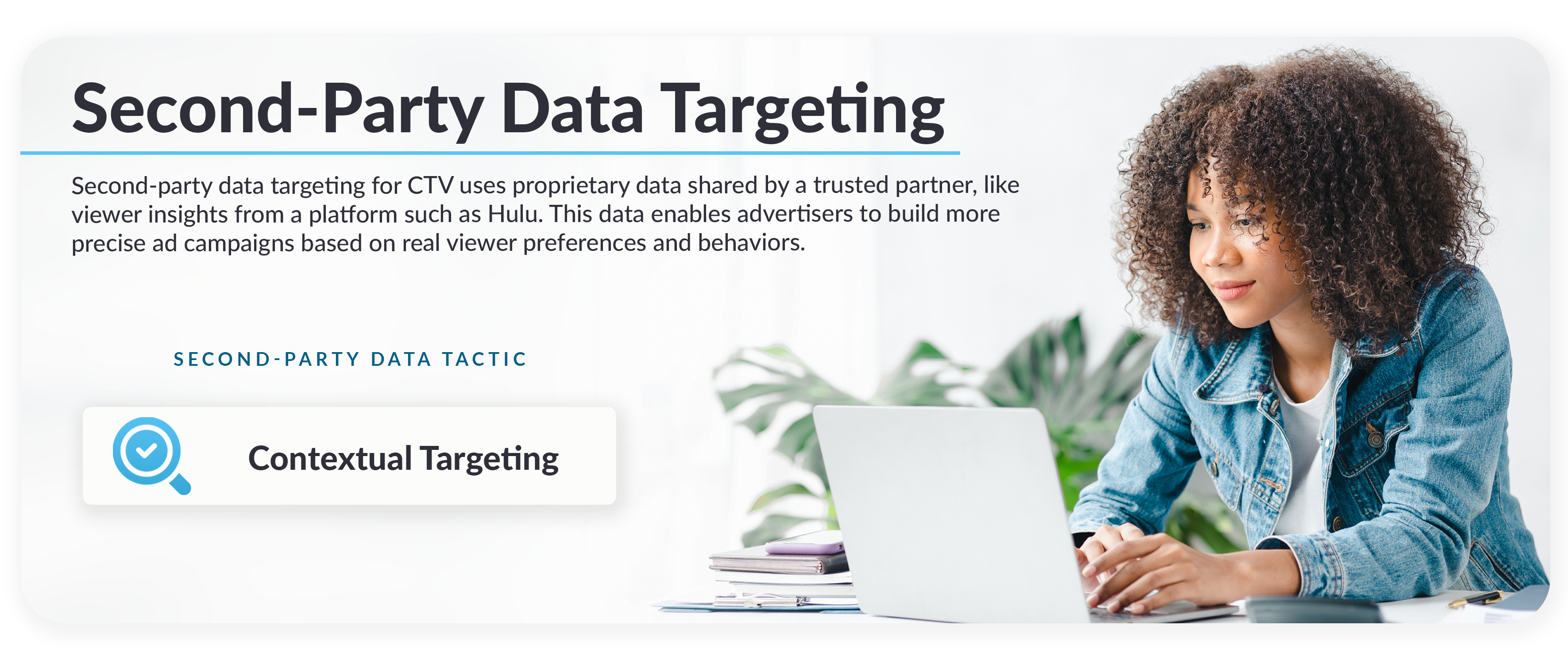
7. Contextual Targeting
Target customers based on their past purchasing patterns, thereby reaching frequent buyers, high-value customers, or specific product categories.
Example: Someone who regularly buys organic produce online might see ads for a local farmers' market.
Retail Data Targeting
Another category that can span first-, second-, and third-party data depending on who’s sharing the information is retail data. Retail data is the customer information collected by major commerce brands like Walmart, Kroger, and Amazon. This is sourced directly from the buyers that brands are trying to reach, and is therefore very reliable and precise.

Retail data and new deterministic identifiers like The Trade Desk’s Unified ID 2.0 are also much more stable and reliable sources of insight than third-party cookies, which is why some are calling retail audiences “the future of data when it comes to programmatic.”

8. Amazon Shopper Intent Targeting
Tap into Amazon’s vast audience targeting data to reach specific audiences with precision.
This combines insights not just from the Amazon ecommerce platform, but also Whole Foods, Kindle, and streaming services like Prime Video, Fire TV, and Freevee.
Example: A person who recently purchased suits, ties, and travel-sized toiletries could be served ads for a luxury business luggage brand.
9. Lapsed Customer Targeting
Bring back previous buyers by engaging them on the biggest screen in the house. Retail data makes it possible to target people who haven’t purchased in a while with personalized, timely offers that motivate action.
Example: A cosmetic brand could use lapsed customer targeting to re-engage customers who haven't purchased their product in the past three months. Knowing that most people go through their products every six months on average, the brand could run a CTV ad reminding those customers to restock and offering a discount on their next purchase.
10. Conquesting Competitor’s Customers
Locate and convert competitor’s customers by using retail data to reach buyers who recently chose a rival brand and show them why your solution is the better fit.
Example: A meal kit delivery service could use this tactic to target households that have recently purchased meal kits from a competing brand — and sweeten the deal with a discount for first-time subscribers.
11. Category Targeting
Focus your campaigns on consumers actively browsing in your product category. Whether they’re exploring online or in-store, your brand will stay top of mind when they’re ready to make a purchase.
Example: While it’s easy to assume this tactic is only relevant to commerce brands, that’s not the case.
Strategus CO-Founder and EVP of Strategy Joel Cox explains:
“Imagine a pet care franchise was looking for pet owners in the area. Retail data could be used to locate those individuals based on recent dog food purchases.”
First-Party Data Targeting
First-party data is the most valuable type of data because it comes directly from the prospects and customers who’ve indicated interest in your brand. One of the most obvious examples of first-party data is a company’s CRM list, which can be used to deliver personalized CTV ads directly to contacts’ living rooms.

12. Website Retargeting
Retarget users who have visited your website with CTV ads in their home, reminding them of your products or services and encouraging them to return to your site or visit a brick-and-mortar location. This usually involves placing a pixel on your website to gather information about visitors.
Example: Ever received an email about your abandoned shopping cart? This is the same idea, but with a big-screen impact.
13. Current Customer Whitelisting
Deliver personalized ads to known customers, enhancing engagement and loyalty by tailoring messages to their specific needs and preferences.
Example: A local lawn care service could use whitelisting to inform their loyal customers about seasonal specials at the start of the summer.
14. Existing Customer Blacklisting
Avoid wasting ad spend by excluding current customers from acquisition campaigns, ensuring that your ads are only shown to potential new customers.
Example: A bank running a campaign to attract new checking account customers could blacklist their existing customers to avoid showing them irrelevant ads.
15. Custom Segmentation
Segment audiences based on CRM data, purchase history, and website interactions for tailored messaging. This allows you to create highly specific audience segments and deliver the most relevant ads possible.
Example: A travel agency could segment their audience based on past travel preferences, such as adventure travel, family vacations, or luxury getaways, and then tailor their CTV ads to showcase relevant destinations and packages.
Custom Targeting Tactics From Strategus
In addition to all the strategies covered above, we’ve developed a handful of proprietary methods at Strategus to make sure that the agencies and brands we partner with get the most out of programmatic CTV.
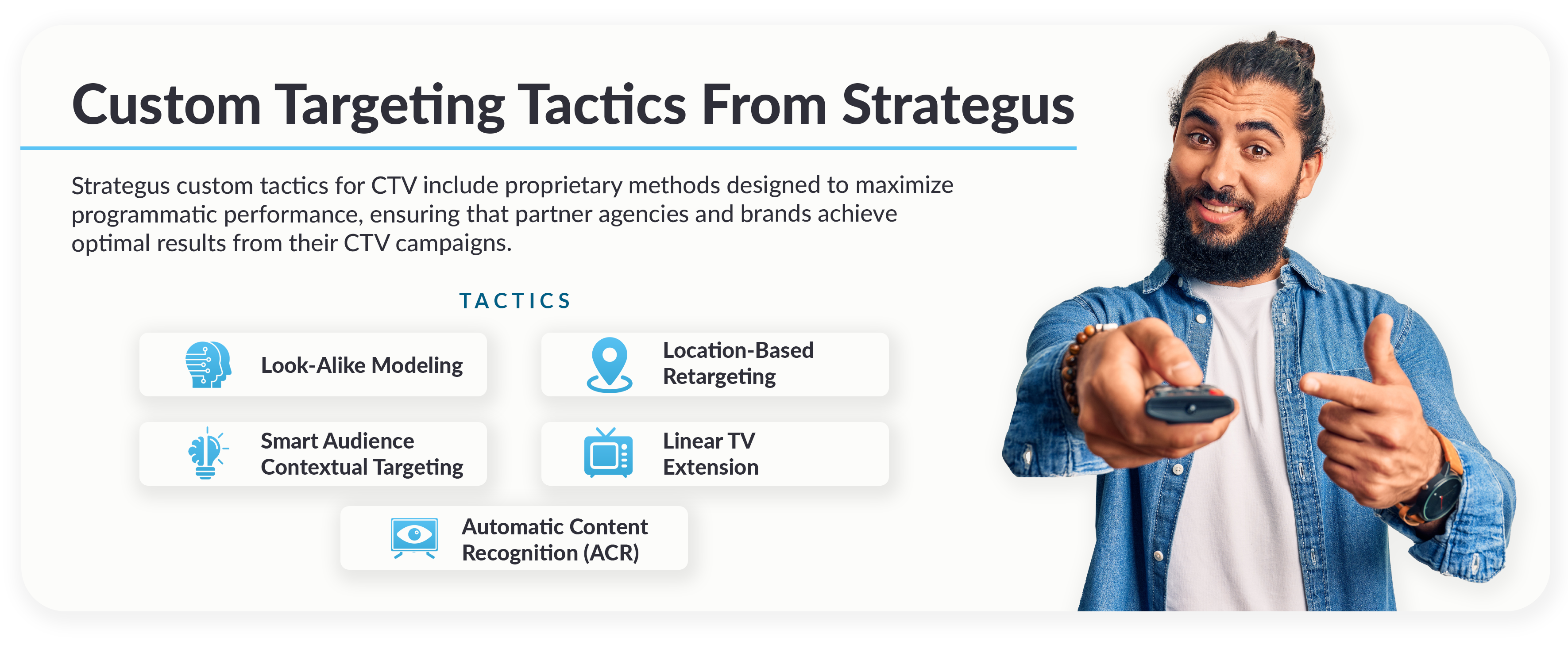
16. Look-Alike Modeling
Use data from your existing customers, website visitors, and CRM files to create look-alike audiences that mirror your best customers, enabling you to reach new, high-potential users who share similar characteristics and behaviors.
Example: A luxury furniture store might use look-alike modeling to identify individuals who exhibit similar shopping patterns as their high-value customers. This could involve analyzing data on demographics, online browsing behavior, and purchase history to identify individuals who are likely to be interested in their products but have not yet made a purchase.
17. Location-Based Retargeting
Reconnect with users who‘ve visited your stores — or conquest foot traffic from competitor locations. Both are powerful tactics to translate physical touchpoints into digital engagement. For example, you could target users who recently visited a competitor's store with an ad showcasing a special offer or promotion.
Example: A University could lure prospective students by retargeting people who’ve recently toured a competing school’s campus.
18. Smart Audience Contextual Targeting
Serve CTV ads to viewers who’ve engaged with online content that’s contextually relevant. This combines the power of contextual and behavioral targeting to reach users who’ve shown interest in a specific product category or industry.
Example: An outdoor gear retailer might use this tactic to locate viewers who’ve recently visited websites or engaged with content related to hiking, camping, or climbing. This would allows the brand to reach a highly receptive audience that’s actively seeking information or products related to their outdoor adventures.
19. Linear TV Extension
Bridge the gap between linear TV campaigns and CTV by targeting households exposed to your TV ads for increased reach and frequency. A combination of both mediums ensures that your efforts aren’t siloed and maximizes the impact of your campaigns.
Example: Any brand can benefit from delivering a holistic experience across different advertising ecosystems. Linear TV extension ensures a consistent experience across streaming and traditional TV ecosystems.
20. Automatic Content Recognition (ACR) Targeting
Reach households based on their TV viewing habits and interests for precise audience alignment. ACR data captures audio or visual snippets from smart TV content and matches them against a large indexed library to identify the types of shows, networks, or competitor ads that a user is tuning into.
Example: This could mean showing an ad for a Lexus convertible to a viewer who regularly watches car shows or motorsports.
Advanced Tactics to Drive CTV Results
21. Dynamic Creative Optimization
Tailor your ads to each segment by using unique visuals and highlighting different products. Imagine an ad for a local car dealership that dynamically adjusted to show sleek convertibles to sports car enthusiasts, while promoting spacious SUVs to families with young children. This type of dynamic personalization is possible, and the possibilities are still being explored.
.png?width=500&height=342&name=Pizza%20dynamic%20creative-min%20(1).png)
Example: Say a pizza franchise wanted to personalize ads to different viewers by instantly displaying the nearest location. A graphic overlay with a store locator could deliver on this requirement, dynamically highlighting nearby stores using the viewer’s location data.
Learn more about dynamic and interactive CTV advertising formats →
22. Cross-Device Retargeting
Drive conversions across supplementary channels by re-engaging viewers who’ve been exposed to a CTV ad across supplementary channels. For instance, a home services provider might run an ad on their target viewers’ living room TV, and then re-engage these same viewers with additional online video, display, and/or streaming audio ads.

This unique approach to CTV advertising allows every customer touchpoint to build on the last interaction. And because it engages viewers in more clickable environments, it drives a 200% increase in conversions.
Example: Imagine someone seeing a commercial for a local spa while winding down for bed. The next day, a display ad could pop up for the same spa — making it simple to schedule a facial in a few simple clicks.
How to Make the Most of Audience Targeting
So now that we’ve detailed all of the strategies at your disposal, what’s the best way to approach CTV targeting? Here are the 10 best practices we share with the agencies and brands we partner with.
- Start with a solid foundation. You’ll want to put in the legwork ahead of time by understanding your ideal customer profile (ICP) and buyer personas. If you lack this type of insight into who your buyers are, then there are a few quick ways to gather insight, such as placing a pixel on your website to get concrete data about your audience’s demographics and shopping behaviors.
- Go beyond basic demographics. Age, gender, location — that's just scratching the surface. Dig deeper into what makes your ideal customer tick. Identify their motivations, pain points, and aspirations. The more you know, the better you can craft ads that speak to their needs.
- Avoid being overly narrow. Finding that sweet spot between precision and scale is key. While casting too wide a net leads to wasted impressions, getting too specific will leave you high and dry with limited reach. We’d suggest starting broad and then narrowing your audience further based on how different segments respond.
- Mix and match data sources. While first-party data is gold because it gives you the inside scoop on your unique customers, third-party data helps you see the bigger picture and uncover potential new audiences. Blending the two allows for a truly powerful targeting strategy that can be further refined based on campaign performance.
- Maximize your share of voice. Strive for a strong presence within your target audience. We suggest aiming for a minimum of 20% share of voice for your brand against the target audience in your target geography. In other words, you want your ads to reach at least 20% of the people you're trying to reach. This ensures your message cuts through the noise and makes an actual impact.
- Personalize your creative to different segments. If you’re segmenting your audience without adjusting the messaging and visuals, you’re missing a crucial step. Different messaging resonates with different buyers. As such, something as simple as tweaking generic ads to highlight specific products, seasonal promotions, or unique value propositions for each segment can significantly boost engagement.
- Fine-tune frequency to prevent ad fatigue. While targeted campaigns are great, bombarding the same viewers with an ad on repeat can be disastrous. To avoid this, make sure your CTV advertising partner offers frequency capping, which limits the number of times a single viewer sees your ad. It’s also a good idea to actively monitor campaign frequency and adjust your strategy if you notice it creeping too high. This might involve expanding your audience, broadening your geographic reach, or refreshing your creative to keep your message engaging.
- Take a full-funnel approach with CTV retargeting. Why stop at targeting when you can also retarget? The best way to drive CTV advertising performance is by retargeting the same users on other devices after the initial ad exposure. For instance, a home services provider might run an ad on their target viewers’ living room TV, and then re-engage these same viewers with additional online video, display, and/or streaming audio ads. This doesn’t just help nurture leads down the funnel, it also reduces the disconnect between different devices.
- Test and optimize. The data-rich environment of CTV advertising makes it a snap to test alternate audience segments. And the more targeting avenues that you have at your disposal, the more opportunities there are to shift budgets toward the highest performing tactics.
- Keep your campaign fresh. After three months of targeting the same viewers, you’ll want to switch it up to engage a different set of eyeballs. Alternatively, you can switch out your creative while targeting the same viewers to ensure that your ads grab viewers’ attention.
Meet Your Customers Where They Are With Strategus
The data-rich world of CTV lets advertisers pinpoint buyers like never before. While some providers tout run-of-mill capabilities like demographic targeting and geofencing, so much more is possible with programmatic CTV.
At Strategus, we go beyond basic demographics to pinpoint exactly who sees your ad — ensuring that every impression drives engagement and action. Our ecosystem of 200+ data providers to achieve the perfect balance of precision and scale. We work with you to identify the perfect mix of data to build custom audiences — often layering five or more of the tactics above.
Schedule a meeting with one of our experts today to find out what your CTV segmentation strategy could look like.

Traci Ruether is a content marketing consultant specializing in video tech. With over a decade of experience leading content strategy, she takes a metrics-driven approach to storytelling that drives traffic to her clients' websites. Follow her on LinkedIn or learn more at traciruether.com.
Strategus is a managed services connected TV(CTV) advertising agency with over 60,000+ campaigns delivered. Find out how our experts can extend your team and drive the result that matter most.
Talk to an Expert
Table of Contents
- How Does CTV Ad Targeting Work?
- What Targeting Strategies Can Be Used to Locate Your Audience?
- Third-Party Data Targeting
- Second-Party Data Targeting
- Retail Data Targeting
- First-Party-Data Targeting
- Custom Targeting Tactics From Strategus
- Advanced Targeting Tactics
- How to Make the Most of Audience Targeting
- Meet Your Customers Where They Are With Strategus
Seeking a Custom CTV Strategy That Delivers?
What to read next

Best SVOD Platforms for Advertisers
The streaming wars have a new battlefront, and this time, it's all about your ad budget. Just a few years ago, SVOD meant "no commercials." Now, it...
12 minutes read

Third-Party Data Targeting for CTV: Benefits & Tactics
Third-party data. It’s a term that’s thrown around, and yet few take the time to detail its pros and cons — much less strategies for using...
7 minutes read

First-Party Data Targeting: Benefits and Tactics for CTV Advertising
First-party data is the information that companies collect directly from their customers rather than through intermediaries. Advertisers use this...
10 minutes read

Foot-Traffic Attribution: Tying Ad Impressions to In-Store Visits
The marketing funnel has changed. Today’s shoppers often begin researching products from the comfort of their homes and don’t set foot into a store...
8 minutes read



